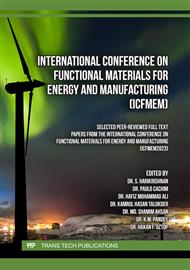[1]
Da Cunha JP, Eames P. Thermal energy storage for low and medium temperature applications using phase change materials–a review. Applied energy. 2016 Sep 1;177:227-38.
DOI: 10.1016/j.apenergy.2016.05.097
Google Scholar
[2]
Kaygusuz K. The viability of thermal energy storage. Energy Sources. 1999 Aug 1;21(8):745-55.
Google Scholar
[3]
Sharma RK, Ganesan P, Tyagi VV, Mahlia TM. Accelerated thermal cycle and chemical stability testing of polyethylene glycol (PEG) 6000 for solar thermal energy storage. Solar Energy Materials and Solar Cells. 2016 Apr 1;147:235-9.
DOI: 10.1016/j.solmat.2015.12.023
Google Scholar
[4]
Sharma RK, Ganesan P, Sahu JN, Metselaar HS, Mahlia TM. Numerical study for enhancement of solidification of phase change materials using trapezoidal cavity. Powder technology. 2014 Dec 1;268:38-47.
DOI: 10.1016/j.powtec.2014.08.009
Google Scholar
[5]
Sivasamy P, Harikrishnan S, Jayavel R, Hussain SI, Kalaiselvam S, Lu L. Preparation and thermal characteristics of caprylic acid based composite as phase change material for thermal energy storage. Materials Research Express. 2019 Aug 23;6(10):105051.
DOI: 10.1088/2053-1591/ab3a78
Google Scholar
[6]
Wang Y, Gao X, Chen P, Huang Z, Xu T, Fang Y, Zhang Z. Preparation and thermal performance of paraffin/Nano-SiO2 nanocomposite for passive thermal protection of electronic devices. Applied Thermal Engineering. 2016 Mar 5;96:699-707.
DOI: 10.1016/j.applthermaleng.2015.11.106
Google Scholar
[7]
Brinker CJ, Cao G. Annual Review of Nano Research. World Scientific; 2006.
Google Scholar
[8]
Manoj Kumar P, Mylsamy K, Saravanakumar PT. Experimental investigations on thermal properties of nano-SiO2/paraffin phase change material (PCM) for solar thermal energy storage applications. Energy Sources, Part A: Recovery, Utilization, and Environmental Effects. 2020 Oct 1;42(19):2420-33.
DOI: 10.1080/15567036.2019.1607942
Google Scholar
[9]
Harikrishnan S, Kalaiselvam S. Preparation and thermal characteristics of CuO–oleic acid nanofluids as a phase change material. Thermochimica Acta. 2012 Apr 10;533:46-55.
DOI: 10.1016/j.tca.2012.01.018
Google Scholar
[10]
Yuan H, Bai H, Lu X, Zhang X, Zhang J, Zhang Z, Yang L. Size controlled lauric acid/silicon dioxide nanocapsules for thermal energy storage. Solar Energy Materials and Solar Cells. 2019 Mar 1;191:243-57.
DOI: 10.1016/j.solmat.2018.11.019
Google Scholar
[11]
Fang G, Li H, Liu X. Preparation and properties of lauric acid/silicon dioxide composites as form-stable phase change materials for thermal energy storage. Materials Chemistry and Physics. 2010 Aug 1;122(2-3):533-6.
DOI: 10.1016/j.matchemphys.2010.03.042
Google Scholar
[12]
Cai Y, Ke H, Dong J, Wei Q, Lin J, Zhao Y, Song L, Hu Y, Huang F, Gao W, Fong H. Effects of nano-SiO2 on morphology, thermal energy storage, thermal stability, and combustion properties of electrospun lauric acid/PET ultrafine composite fibers as form-stable phase change materials. Applied Energy. 2011 Jun 1;88(6):2106-12.
DOI: 10.1016/j.apenergy.2010.12.071
Google Scholar
[13]
Kumar PM, Mylsamy K. Experimental investigation of solar water heater integrated with a nanocomposite phase change material. Journal of Thermal Analysis and Calorimetry. 2019 Apr 15;136(1):121-32.
DOI: 10.1007/s10973-018-7937-9
Google Scholar
[14]
Wang J, Xie H, Xin Z. Thermal properties of paraffin based composites containing multi-walled carbon nanotubes. Thermochimica Acta. 2009 May 5;488(1-2):39-42.
DOI: 10.1016/j.tca.2009.01.022
Google Scholar
[15]
Amin M, Putra N, Kosasih EA, Prawiro E, Luanto RA, Mahlia TM. Thermal properties of beeswax/graphene phase change material as energy storage for building applications. Applied Thermal Engineering. 2017 Feb 5;112:273-80.
DOI: 10.1016/j.applthermaleng.2016.10.085
Google Scholar
[16]
Kim DH, Ryu HW, Moon JH and Kim J 2006 Effect of ultrasonic treatment and temperature on nanocrystalline TiO2 J. Power Sources 163 196–200.
DOI: 10.1016/j.jpowsour.2005.12.060
Google Scholar
[17]
Zhu D, Li X, Wang N, Wang X, Gao J and Li H 2009 Dispersion behavior and thermal conductivity characteristics of Al2O3 –H2O nanofluids Current Appl. Phys. 9 131–9.
DOI: 10.1016/j.cap.2007.12.008
Google Scholar
[18]
O'connell MJ, Bachilo SM, Huffman CB, Moore VC, Strano MS, Haroz EH, Rialon KL, Boul PJ, Noon WH, Kittrell C, Ma J. Band gap fluorescence from individual single-walled carbon nanotubes. Science. 2002 Jul 26;297(5581):593-6.
DOI: 10.1126/science.1072631
Google Scholar
[19]
Sivasamy, P., S. Harikrishnan, and A. Devaraju. "Experimental investigation of improved thermal characteristics of Al2O3 /barium hydroxide octa hydrate as phase change materials (PCMs)." Materials Today: Proceedings 5, no. 6 (2018): 14440-14447.
DOI: 10.1016/j.matpr.2018.03.030
Google Scholar
[20]
Ibrahim SA, Sreekantan S. Effect of pH on TiO2 nanoparticles via sol-gel method. InAdvanced Materials Research 2011 (Vol. 173, pp.184-189). Trans Tech Publications Ltd.
DOI: 10.4028/www.scientific.net/amr.173.184
Google Scholar
[21]
Wang, J, Xie, H, Xin, Z, Li, Y & Chen, L 2010, 'Enhancing thermal conductivity of palmitic acid based phase change materials with carbon nanotubes as fillers Sol', Energy, vol. 84, pp.339-344.
DOI: 10.1016/j.solener.2009.12.004
Google Scholar
[22]
Karaipekli, A, Biçer, A, Sarı, A & Tyagi, VV 2017, 'Thermal characteristics of expanded perlite/paraffin composite phase change material with enhanced thermal conductivity using carbon nanotubes', Energy conversion and management, vol. 134, pp.373-381.
DOI: 10.1016/j.enconman.2016.12.053
Google Scholar
[23]
Mishra AK, Lahiri BB, Philip J. Thermal conductivity enhancement in organic phase change material (phenol-water system) upon addition of Al2O3, SiO2 and TiO2 nano-inclusions. Journal of Molecular Liquids. 2018 Nov 1;269:47-63.
DOI: 10.1016/j.molliq.2018.08.001
Google Scholar
[24]
Sim L, Ramanan SR, Ismail H, Seetharamu KN, Goh TJ. Thermal characterization of Al2O3 and ZnO reinforced silicone rubber as thermal pads for heat dissipation purposes. Thermochimica acta. 2005 Jun 1;430(1-2):155-65.
DOI: 10.1016/j.tca.2004.12.024
Google Scholar
[25]
Liu M, Lin MC, Wang C. Enhancements of thermal conductivities with Cu, CuO, and carbon nanotube nanofluids and application of MWNT/water nanofluid on a water chiller system. Nanoscale research letters. 2011 Dec;6(1):1-3.
DOI: 10.1186/1556-276x-6-297
Google Scholar


